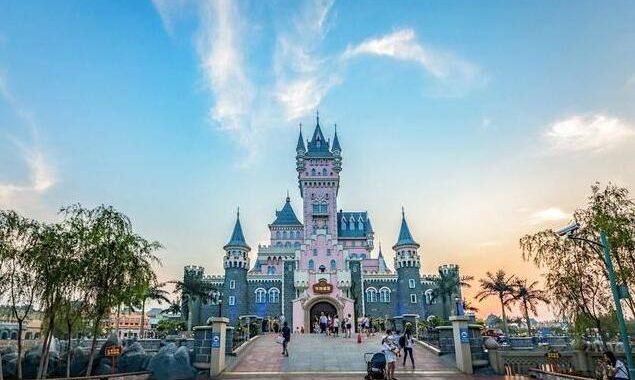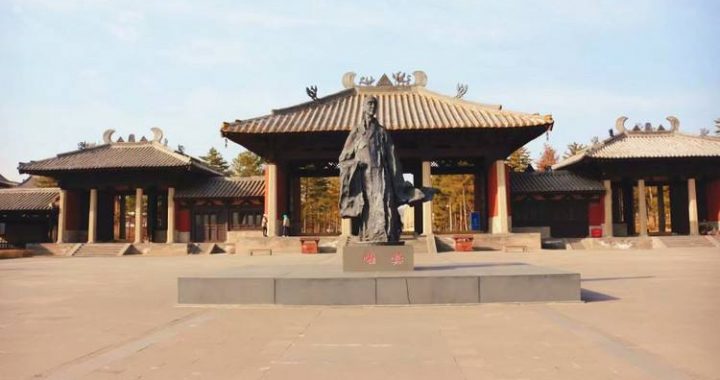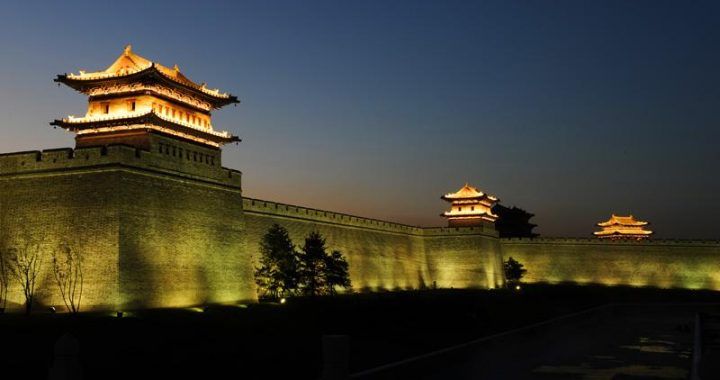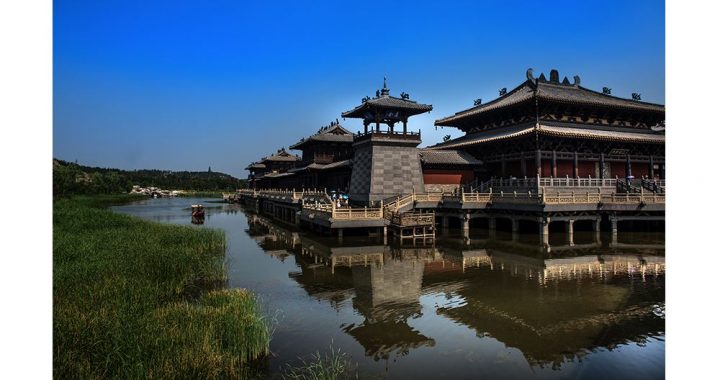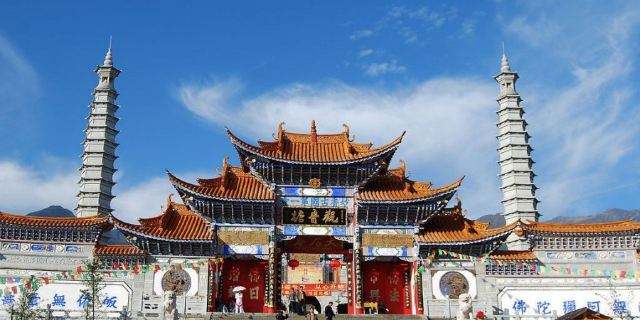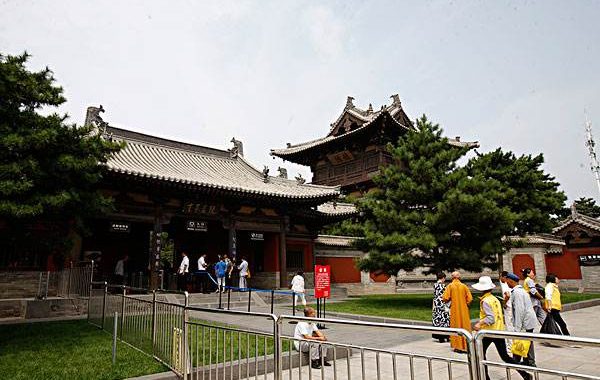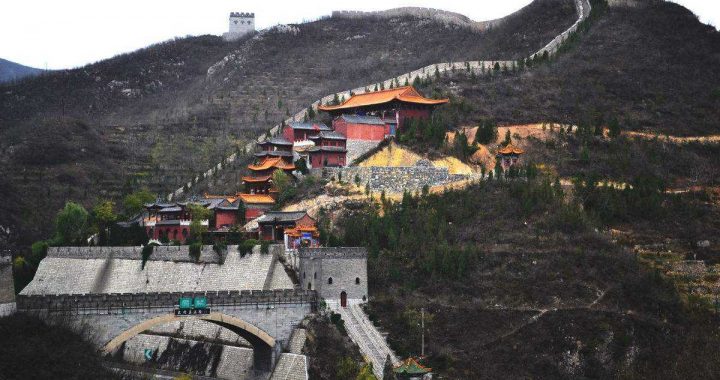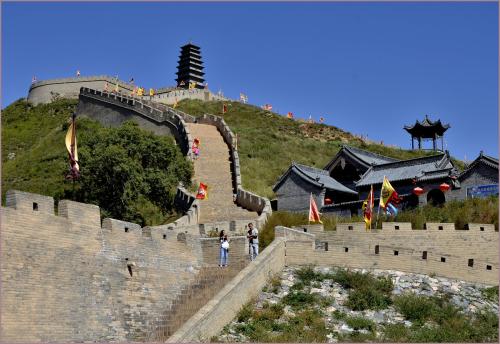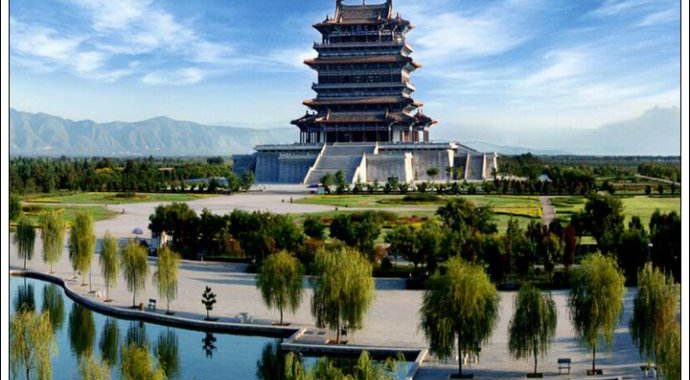Oriental Buddha Capital
13 min readLike an auspicious cloud, the Indian Buddhist robe inlaid with the gilt edge of Mahayana and Theravada, fell on the land of ancient China in the time of the Eastern Han Dynasty. The Northern Wei Dynasty explored a way of ensuring national integration through a consistent faith and realizing unification through national integration. Hence, it managed to piously build the capital Pingcheng (Datong) into a center of Buddhism.

The Tuoba tribe created Chinese Buddhism by combining the Shamanism that flourished in the forest and grassland regions, Confucianism and Taoism of theCentral Plains, and the Buddhist tenets introduced from northwestern India. The capital, Pingcheng, became the main focus of the evolution of this multi-faceted faith.
In the Relationship between Buddhism and Chinese Culture, Zhao Puchu has pointed out that Chinese traditional culture since the Wei, Jin and Southern and Northern dynasties had not been the original pure Confucian culture, but instead involved acombination with Buddhism and Taoism. This combination first appeared in Pingcheng of the Northern Wei Dynasty.
Although involving many differences, Confucianism, Buddhism and Taoism are still somewhat related and complement each other. Confucianism was developed to rule the nation, Buddhism functions to cultivate the mind, and Taoism aims to attain mental tranquility.
Confucianism stresses the “body”,i.e. earnestly practicing what one preaches. It advocates entering society actively, restraining oneself and maintaining a strong sense of propriety, reconciling the social order according toRites of Zhou, cultivating oneself, regulating the family and ruling the state. ZengGuofan had deep experience:’ Start with self-cultivation, and end by benefiting the mankind’. Confucianism pursues the harmony and natural unity of rites and music.
Buddhism pays attention to the soul, namely mental cultivation. As long as the heart is pure, there is no dust. Mood and mind are inherently linked. As summarized in The Surangama Sutra, body and mind are united, and the nature is a reflection of the mind.
Taoism emphasizes “spirit”,i.e. spiritual cultivation, and governance by doing nothing that is against nature. The ‘ Carefree Journey’ article in Chuang Tzu describes the unrestrained and free mood, and conveys the wonders of Taoism:’ InGushe Mountain lives an immortal who is as white like snow and ice, and of pure simplicity He does not eat grain, but only enjoys the morning dew. Riding a dragon, he travels around the world’.
The Northern Wei Dynasty expanded its territory to Loulan, Qiuci, Liangzhou, etc. Works of early Buddhist art and a number of monks’ handicrafts were taken tothe capital Pingcheng. In 439 or the fifth year of the reign of Emperor Shizu in Northern Wei Dynasty, Liangzhou was captured, and local people including monks moved to Pingcheng, where Buddhist temples flourished. Since the reign of Emperor Taiwu, the Northern Wei Dynasty had frequent exchanges with states in the Western regions, where the construction of Buddhist temples was popular; some states or regions were even included in the territory of the Northern Wei.
The Northern Wei Dynasty was a Buddhist dynasty, and Pingcheng was a matchless city of Buddhism. Datong has inherited this attribute and is known as ‘ Buddhist Land’. Shui Jing Zhu (Commentary on the Waterways Classic) says:’ Buddhism is popular in the capital. Temples and pagodas look at each other, with the rotating Dharma-cakra’ The wonders include the Lingyan Caves on Wuzhou Hill with world-renowned magnificent religious ornaments, the world’s No.1 seven-storey pagoda in YongningTemple, and the spectacular Tiangong Temple and Five-Storey Temple. Jinglun Palace has pavilions ‘ as high as the sky’. The solemn five-storey pagoda in Huangjiu Temple contains brilliant bluestone statues decorated with gold and silver.
Once a new statue was completed in the temple, the capital would hold a grand ceremony, described thus:’ On the day of unveiling the statue,[ the atmosphere] wasvery boisterous. Thousands of horses and carriages cleared the way. Golden flowers shone in the, and towers seemed very high. Numerous banners swayed, and incense smoke filled the air with mist. Various kinds of art performances and music were available. Monks danced, and people bowed down to worship Buddha. People crowded together to personally witness the emperor and his parents.’ Numerous people came to worship Buddha in the Lingyan Temple in particular.

In 477 or the 7th year of the reign of Emperor Gaozu in the Northern Wei Dynasty, there were over 100 temples both new and old filled with more than 2,000 monks and nuns. Crowds of monks in glorious robes created the image of “flames walking along the road”. At this time, there were a total of 6,478 temples and nearly 80,000 monks and nuns in the Northern Wei territory. During the period from 520-525 or during the reign of Emperor Suzong, the number of monks and nuns rose to two million. The History of the Northern Wei Dynasty records that,”since the Northern Wei Dynasty [ was founded], Buddhist sutras had been spread·… in an unprecedented way.”
Liu Xiaobiao translated many volumes of Buddhist scriptures in Datong, and a translation table was specially designed in Yungang Grottoes. The cultural relics unearthed from Dunhuang include many classics created in the Northern Wei Dynasty.
Although, the Northern Wei Dynasty advocated Buddhism, there was one terrible bloody event involving the slaughter of monks. Much of the oppression was initiated by Emperor Shizu(with the posthumous name of Taiwu), who is referred to as one of the Three Wu and One Zong”(namely, Emperor Taiwu of the Northern Wei Dynasty, Emperor Gaozu(with the posthumous name of Wu) of the Northern Wei Dynasty, Emperor Wu of the Northern Zhou Dynasty, Emperor Wuzong of the Tang Dynasty, and Emperor Shizong of the Late Zhou Dynasty).
In the beginning, Emperor Shizu advocated Buddhism, but changed his mind in the middle course. In 444, the 2lst year during the reign of Emperor Shizu in the Northern Wei Dynasty, he banned any person from privately supporting monks, which threatened the elimination of virtually every family. In 445, under the leadershipof Gai Wu of the northern minority, more than 100,000 people rose up in Xingcheng(today’s Huangling County, Shaanxi) and Emperor Shizu led his soldiers to suppressthe movement. When passing by one temple in Chang’ an, he found hidden weapons suchas bows and arrows, spears and shields, as well as amassed property and cave rooms for sexual entertainment. Emperor Shizu sneered at it:”Since these things do no belong to temples, the monks must have colluded with Gai Wu.”So he ordered to slaughter monks, burnt Buddha statues and scriptures, and demolished pagodas and temples. The whole country was thrown into unrest and terror.
Emperor Shizu’s actions mainly stemmed from three causes: First, the temple economy of the Northern Wei Dynasty became increasingly powerful, threatening thenational economic lifeline; secondly, Buddhism had become unprecedentedly popular.
The people preferred revering and relying on the Buddha to imperial power, thus causing a crisis in national faith; thirdly, Taoist Kou Qianzhi left the Songshan Mountain in Henan Province for the capital to preach. Emperor Shizu strongly believed in Taoism, and appointed Kou as ‘ imperial master’. He also the construction of a five-storey tower named “Master’s Rites”for him.
Emperor Shizu’s suppression of Buddhism essentially arose from the conflict between the alien Buddhist culture and the local Confucianism and Taoism. It’s the first open confrontation between them since the introduction of Buddhism.
Situations develop in the opposite direction when they become extreme. Emperor Shizu’s suppression of Buddhism accelerated its fusion and helped create the Yungang Grottoes. Upon taking the throne, Emperor Gaozong ordered unsparing effortsto bring into play full role of multi-ethnic craftsmen from Liangzhou, the CentralPlains and other regions. They included the eminent monk Tan Yao, the talented Wang Yu, and sculptors Dai Kui and his son of the Southern Dynasties. Many statue arts of India were used for reference, and various sculpting techniques emerged. Much activity in the digging of caves and making statues was seen on Wuzhou Hill. The excellent accuracy and color of the statues helped create the exquisite and glorious Yungang Grottoes.
Since the beginning, digging grottoes had been strongly supported by the people.
When the “Five Grottoes of Tan Yao”were first unveiled, the celebrations were very grand and lively affairs: monks welcomed the arrival of Buddhist relics from Fengxiang, and the people rejoiced.
Yungang Grottoes resulted from the consistent guiding ideology of “the emperor is Tathagata”which was upheld by five emperors, including Emperor Taizu of the Northern Wei Dynasty. Yungang Grottoes is the carrier of the State and national wi11. Each emperor created part of the history of the Northern Wei Dynasty, which affected the reality and connected the future.
What is the spirit of the Chinese people? Gu Hongming, who served as the assistant to Zhang Zhidong for nearly 20 years, declared:”the spirit of the Chinese people is the mood of feeling things quietly and leisurely and enjoyingnature, and is the imaginative rationality.”In front of grand and silent Yungang Grottoes, one is drawn to become as one with nature. Everyone must feel intoxicated and moved, and will recall the scene repeatedly later. Try to feel and listen to Yungang Grottoes attentively with your hearts. You might become the serene stones able to hear the melody of flowing water and the sound of flowering lotus.
The Northern Wei Dynasty spared no effort to develop Buddhism. It was popular in the capital Pingcheng and Luoyang, and also spread to Dunhuang and Maiji, Tianlong and Xiangtang mountains.
Except for Hengshan, other four sacred mountains of China were controlled by the Northern Wei Dynasty. Xiyue Temple, known as the first temple in Huashan, and Shaolin Temple in Songshan, were built by the dynasty, as where Yuquan Temple and the Taoist shrine Daiyue Temple in Taishan.A stream passes by the Doumu Palace in Taishan. One stone inscription of The Diamond Sutra, as high as half a meter, is particularly solemn. Bright moon, river rocks, clear spring and scripture show the excellent engraving skill of the Northern Wei Dynasty.
In the dynasty, many temples were built in succession. They include Foguang Temple on Wutai Mountain, Qingliang Temple, Xiantong Temple, Hunyuan Xuankong Temple, Lingqiu Jueshan Temple, Jiaocheng Xuanzhong Temple, Lofty Happiness Temple in Shuozhou with thousands of Buddha statues and stone pagodas, red sandstone statues in Qin County, and Henan Shaolin Temple… Now the grotto statues inQinyuan County of Shanxi, and Prairie Yungang, namely the grotto buildings on Aerzhai Mountain, west of Ordos Grassland in Inner Mongolia, are preserved well.
They are rare relics of Buddhist culture of the Northern Wei Dynasty.
After crossing the Hutuo River Valley along the National Highway 108, you enter the area of Wutai Mountain where there is a village with a nice name-Princess Village. There, one can find Princess Temple, built about 1,500 years ago, and one of the earliest Buddhist temples in the region. Who was the princess? She was the daughter of Emperor Gaozu of Northern Wei given the title of ‘ Integrity Princess’. Emperor Gaozu ordered temple built for her when she became a nun.
The world culture heritage site of Wutai Mountain contains the ashram of Manjushri Bodhisattva. The Ancient Records on Qingliang Mountain was created between the Yonglong and Hongdao years during the reign of Emperor Gaozong of the Tang Dynasty. The Records on Mountains and Wonders of Dunhuang edition was created between the August 680 to September 681 and in December 683 during the reign of Emperor Gaozong of the Tang Dynasty. The Records on Mountains and Wonders of Dunhuang edition was created during the period from April 923 to February 930. The two books both record the legends about Manjusri Bodhisattva developing Wutai Mountain and about Emperor Gaozu of Northern Wei ordering the building of a temple: When arriving at the foot of Wutai Mountain, the Emperor came across an old monkbegging him to build a temple on the piece of land where he sat. Just as EmperorGaozu answered, the seat under the monk began to move. Like a flowering lotus, the seat became larger and larger until it had a diameter of 250 km with the mountain as the center. That is why today’s Wutai Mountain is so wide. Emperor Gaozu was surprised at first, but soon began to laugh out loud. In fact, the monk was the incarnation of Manjushri Bodhisattva.
In 494, Emperor Gaozu of Northern Wei and many companions moved from Datong to southern Luoyang. One hundred skilled craftsmen carved the caves along the road, andopened a gallery of Buddhist art especially grotto sculpture. According to the rout map of investigation by Liang Sicheng in Shanxi, the archeology professor Li Ling of Peking University recorded: during the Northern and Southern Dynasties, there were two routes for spreading Buddhist arts. One route was from Datong to Luoyang (north-south), and the other from Changzhi to Hebei and Shandong (east-west). The Xiangtan Moutnain Grottoes in the Fengfeng region and cliff inscriptions of sutra in Shandong lie on the latter route.
The monk culture that developed with the spread and localization of Buddhism represented a surge of Chinese culture. This can be interpreted in two aspects: first, eminent monks studied the Buddhist doctrines, and, in the process, became a unique cultural elite; second, the cultural behavior of Buddhists include worshiping Buddha and preaching, and they made special contributions to cultural creation.
There were many eminent monks in the Northern Wei Dynasty, including Faguo, Shixian, Xuangao, Huichong, Tan Yao, Daobian, Lingbian, Puti Liuzhi and Huiguang. The monk management agency had been specially established in the Northern Wei Dynasty. It was initially named as “Jian Fu Cao”but was changed to “Zhao Xuan Si”later. The monk official had the title of “Dao Ren Tong”. Liu Xiaobiao and Wei Shou were not monks, but they made contributions to the monk culture. Liu translated many volumes of scriptures in Datong, and a translation table was specially set up in YungangGrottoes. The History of the Northern Wei Dynasty· Records on Buddhism and Taoism became the ‘ official records’ of Buddhism and Taoism.
Monk Huiyuan played an important role in the monk culture of the Northern Wei Dynasty. He lived in the Eastern Jin Dynasty (334-416). He belonged to the Loufan tribe in Yanmen in Daixian County (close to Datong). At first, Huiyuan and his teacher Daoan expounded and carried forward the Buddhist doctrines on the HengshanMountain in Shanxi, dedicating themselves to the integration of Confucianism, Taoism and Buddhism. He first advocated the “internal and external cultivation”. He was proficient in understanding the six ancient classics, especially the theories of Lao Tzu and Chuang Tzu. As an experienced scholar with the generous temperament, he was handsome, but his thoughts were very profound. The historian Chen Yinque sighed with emotion:’ Monk Huiyuan was the sole one who analyzed the similarities anddifferences of sects and their theories during the Northern and Southern Dynasties’.
Huiyuan moved southwards and lived in the Longquan Temple on the side of Lushan Mountain. He lived a secluded life and never left the mountain. He never crossed the Huxi Creek when seeing off visitors. He built the Donglin Temple, and was respectfully called as Buddhist Pure Land School Ancestor.(His younger brother Monk Huichi was the founder of Buddhism School in Emei Mountain in Sichuan Province.) Kumarajiva praised Huiyuan as the “oriental Bodhisattva of doctrine protection”.
Huiyuan’s Donglin Temple in Lushan Mountain and the Kumarajiva’s Scripture Translation Place in Happy Garden of Chang’ an were two centers of Buddhism in the north and south. Huiyuan accepted seclusion to seek a real simple existence while living a secular life to achieve the Dao (way). As recorded in the Theories of Master Monk: The kasaya and alms bowl are incompatible with the imperial court’ He vowed to rescue the secular world by taking more measures.
A new pattern of “cultivating both meditation and wisdom”appeared in the Sui Dynasty. There were so many temples in the Tang Dynasty continuing the glory of the Northern Wei Dynasty. Two lines of one famous poem declare:’ so many splendid temples of the Southern Dynasty, now form a misty rain’. The Buddha statue of the Liang Dynasty that was unearthed from Ten Thousand Buddhas Temple in Chengdu, Sichuan, has both the Chinese style and also the Indian Gupta style. The latter style was spread from Pingcheng (Datong) in the Northern Wei Dynasty.
The Liao and Jin dynasties always advocated Buddhism, and most temples were self-sufficient. After the Liao Dynasty occupied sixteen prefectures in Yanyun,a large number of Han people moved northward. The Liao Dynasty began to pay attention to Buddhism and build temples, and spared no effort in publishing scriptures, which made Buddhism popular. Huayan Temple, Pu’ en Temple, Avalokitesvara Temple, and Foge Temple in front of Yungang Grottoes constituted the Buddhist cultural circle of the Liao and Jin dynasties. The wonderful Yungang Grottoes reflect the unique and charming architectural art of the Liao Dynasty. In front of Yungang Grottoes, ten temples and pavilions were built in succession. They function to protect the stone Buddha statues, and also show the artistic creation of the Khitan people.
In the Jin Dynasty, Yungang Grottoes, Huayan Temple and Shanhua Temple separately had the “golden stele”recording the repair and care of treasures, and the sculptural fingerprints were left in the Yungang Grottoes. Annals of Shanxi records that 20 stone Buddha statues in 10 temples were repaired during the reign of Emperor Xizong(1141-1149) in the Jin Dynasty. Eventually, however, they were destroyed by war.
In the Tang Dynasty, Buddhism was popular in Datong. The sweet-sounding and loudBrahma voice could be heard. The “Golden Stele”records:”Yungang Grot toes were rebuilt in 641 or the 15th year of the reign of Emperor Taizong in the Tang Dynasty’. The Ancient Records on Qingliang Mountain also records:’ Yan Chan master of Tang Dynasty repaired the old statues of Yungang Grottoes in Pingcheng(Datong). In the third grotto of Yungang Grottoes, there only exist three large Buddhist statues, which are graceful and splendid, and exquisite. As to style, they are similar to the statues of the Tang Dynasty in Longmen Grottoes. In the Yuan Dynasty, Datong was still regarded as an important Buddhist center. The History of the Yuan Dynasty· Biography of Emperor Shizu records…’ that year, over 40,000 monks gathered in Pu’ en Temple (Shanhua Temple) in Xijing (Pingcheng), and held a ceremony for seven days and nights.”

In the early years after liberation, there were 64 temples of different sizes.
Today, Datong sti1l has 43 streets with the temple names, accounting for 23% of the total number of streets. The names include Xiasi Slope, Shangsi East Lane, Shangsi South Lane, Shangsi North Lane, Nansi Street, Xingguo Temple and Jile Temple…
Today, Datong is building the “sacred land of pilgrimage”. The auspicious clouds and incense smoke of the past “Oriental Buddha Capital”will reappear in the sky.
